|
|
 |
|
Cyclopoida ( Order ) |
|
|
|
Oncaeidae ( Family ) |
|
|
|
Triconia ( Genus ) |
|
|
| |
Triconia elongata Böttger-Schnack, 1999 (F,M) | |
| | | | | | | Syn.: | "Oncaea dentipes form B" (Males, non females): Böttger-Schnack, 1996. | | | | Ref.: | | | Böttger-Schnack, 1999 (p.43, 97, figs.F,M); Böttger-Schnack & al., 2001 (p.1029, tab.1, 2); Böttger-Schnack & al., 2004 (p.1130, tab.1, Rem.); Böttger-Schnack & Machida, 2011 (p.111, Table 1, 2, fig.2, 3, DNA sequences, phylogeny); Wi & al., 2012 (p.852: Table 1; p.853: Table 1, 2); Cho & al., 2013 (p.18, figs.F, Descr. variant form) | 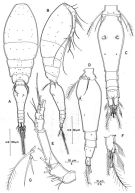 issued from : R. Böttger-Schnack in Mitt. hamb. zool. Mus. Inst., 1999, 96 [p.98, Fig.27]. Female (from Red Sea): A, habitus (dorsal); B, idem (lateral right side); C, urosome (dorsal); D, idem (lateral right side); E, A1; F, caudal ramus (dorsal, long terminal setae omitted); G, P5 (dorsal). Nota: Proportional lengths (%) of urosomites and caudal rami 8.9:54.6:8.6:7.9:11.7:8.6. Relative lengths (%) of segments of A1 measured along posterior non-setigerous margin 7.1:19.1:46.2:12.9:4.0:10.7.
|
 issued from : R. Böttger-Schnack in Mitt. hamb. zool. Mus. Inst., 1999, 96 [p.99, Fig.28]. Female: A, A2 (anterior); B, labrum (anterior); C, idem (posterior); D, Md (showing individual elements); E, Mx1; F, Mx2; G, Mxp.
|
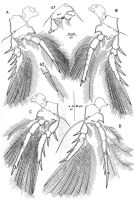 issued from : R. Böttger-Schnack in Mitt. hamb. zool. Mus. Inst., 1999, 96 [p.102, Fig.29]. Female: A, P1 (posterior) [a1, xoxa and 1st segment of endopod and exopod, anterior, showing surface ornamentation; a2, distal part of endop-3, anterior]; B, P2 (anterior); C, P3 (anterior); D, P4 (posterior).]
|
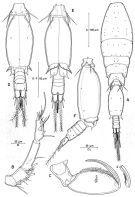 issued from : R. Böttger-Schnack in Mitt. hamb. zool. Mus. Inst., 1999, 96 [p.103, Fig.30]. Male (from Red Sea): A, habitus (dorsal); B, A1; C, Mxp (anterior) [c, proximal part of endopodal claw, showing fused pectinate spine]; D, urosome (dorsal (spermatophores extruding); E, idem (ventral); F, idem (lateral right side). Nota: Proportional lengths (%) of urosomites and caudal rami 6.6:56.4:5.4:5.4:5.1:11.7:9.3. Relative lengths (%) of segments of A1 measured along posterior non-setigerous margin 5.9:20.3:44.9:28.9.
|
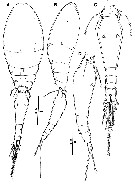 Issued from : K. Cho, W.-S. Kim, R. Böttger-Schnack & W. Lee in J. Nat. Hist., 2013. [p.19, Fig.6]. Female (10°30'N, 131°20'W): A, habitus (dorsal); B, habitus (lateral); C, urosome (dorsal); D, urosome (lateral). Scale bars in µm. Nota : Exoskeleton moderately chitinized, surface covered with numerous small pits. Prosome 1.6 times length of urosome, excluding caudal rami, about 1.5 times urosome length including caudal rami. P2-bearing somite with out dorsoposterior projection in lateral aspect. Integumental pores on prosome as indicated fig.6A, B. Pleural areas of P4-bearing somite with small pointed posterolateral corners. Integumental pores on urosomites (fig.6D) similar to T. pacifica. Genital double-somite about 1.6 times as long as postgenital somites combined, with elongate flask-like form ; largest width measured at anterior third, lateral margins slightly rounded, posterior 2/3 tapering gradually. Dorsal surface paired genital apertures located at about 2/5 of distance from anterior margin and paired secretory pores posterior to genital apertures. Anal somite slightly longer than wide ; 1.5 times longer than caudal rami. Caudal ramus about 1.5 times as long as wide.
|
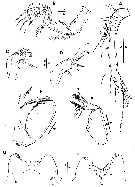 Issued from : K. Cho, W.-S. Kim, R. Böttger-Schnack & W. Lee in J. Nat. Hist., 2013. [p.21, Fig.8]. Female (NE equatorial Pacific): A, A1: B, A2 (posterior); C, Md; D, Mx1; E, Mx2; F, Mxp (anterior), elements on inner margin of basis figured separately, insertion points of elements on basis indicated by stippled line; G, labrum (anterior); H, labrum (posterior). Scale bars in µm. Nota : A1 6-segmented. Armature formula as for T. pacifica. A2 3-segmented, relative lengths (%) of segments 40 : 34 : 26 (similar to T. pacifica). Labrum with 5 to 6 large dentiform processes medially along distal margin of each lobe, processes differing in size and shape. Anterior surface fig. 7G) with spinular patch on either side of median swelling, lacking integumental pockets. Posterior surface (fig.7H) with group of 3 secretory pores on proximal part of each lobe and additional pair on midregion. Md similar to that of T. pacifica, except for dorsal blade with large dentiform processes along half dorsal and entire distal margins. Mx1 similar to T. pacifica, even with respect to minor ornamentation details. Mx2 similar to thart of T. pacifica. Mxp similar to T. pacifica, eccept for spiniform element on basis stout and stronger than in T. pacifica.
|
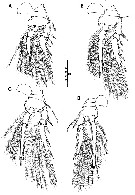 Issued from : K. Cho, W.-S. Kim, R. Böttger-Schnack & W. Lee in J. Nat. Hist., 2013. [p.21, Fig.8]. Female (NE equatorial Pacific): A-D, P1 to P4 (anterior views). Scale bar in µm.
|
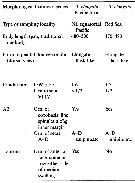 Issued from : K. Cho, W.-S. Kim, R. Böttger-Schnack & W. Lee in J. Nat. Hist., 2013. [p.16, Table 2]. Morphological characters of Triconia elongata of the Triconia dentipes-subgroup from the north-eastern equatorial Pacific. Nota: Orn: ornamentation; L: length; W: width; Compare with related species and form variants of the Triconia dentipes-subgroup from the north-eastern equatorial Pacific and from other regions: T. dentipes, T. pacifica, T. giesbrechti (Pacific form), T. giesbrechti (Red Sea form), T. constricta.
|
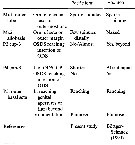 Issued from : K. Cho, W.-S. Kim, R. Böttger-Schnack & W. Lee in J. Nat. Hist., 2013. [p.17, Table 2 (Continued)]. Morphological characters of Triconia elongata of the Triconia dentipes-subgroup from the north-eastern equatorial Pacific. Nota: Orn: ornamentation; L: length; W: width; OSDS: outer subdistal spine; ODS: outer distal spine; CP: distal conical process Compare with related species and form variants of the Triconia dentipes-subgroup from the north-eastern equatorial Pacific and from other regions: T. dentipes, T. pacifica, T. giesbrechti (Pacific form), T. giesbrechti (Red Sea form), T. constricta.
| | | | | Compl. Ref.: | | | McKinnon & al., 2008 (p.844: Tab.1); Nishibe & al., 2009 (p.491, Table 1: seasonal abundance); Böttger-Schnack & Schnack, 2009 (p.131, Table 3, 4, Rem.) | | | | NZ: | 5 | | |
|
Distribution map of Triconia elongata by geographical zones
|
| | | | | | | | | | Loc: | | | Medit. (Balearic Basin, Strait of Sicily, Ionian Sea, Lebanon Basin), Red Sea (N-S), Australia (North West Cape), Japan (Tosa Bay), NE tropical Pacific | | | | N: | 6 | | | | Lg.: | | | (810) F: 0,470-0,480; (pers. comm.) F: 0,450-0,510; M: 0,390; (1166) F: 0,544; {F: 0,45-0,544; M: 0,39} | | | | Rem.: | epipelagic.
For Böttger-Schnack (1999, p.104) this species is closely related to T. dentipes and T. giesbrechti from which it can be distinguished by differences in the form of genital double-somite, size and ornamentation of P5, length of teminal accessory sta VI on caudal ramus and the ornamentation of labrum.
After Cho & al. (2013, p.23) The form variant from the Pacific strongly resembles the typical form of T. elongata Böttger-Schnack, 1999 from the Red Sea most morphometric characters, notably the elongate flask-like form of the female genital double-somite, and the length of the outer basal seta on P5, which is reaching as far as the genital apertures. The two form variants were furthermore separated by very few micro-structures, including: 1- the spinular row either side of the median swelling on the anterior surface of the labrum being present in the Pacific form variant, but not in the typical form, and 2- the spibulose ornamentation of the seta on the outer allobasal margin of the Mx2, which is naked in the typical form. All other micro-characters including those on the A2 coxobasis, the elements on Mx1, and the outer basal seta on P5, were similar in both forms.
See also Triconia constricta. | | | Last update : 02/02/2015 | |
| | | | The size range of female Triconia elongata in the original description (your ref. 810) was 0.470-0.480 mm, with an average of 0.475 mm, based on two specimens from the eastern Mediterranean Sea (Böttger-Schnack 1999, p.99, 100), not 0.480 mm and 0.475 mm as given above. During a recent cruise along a west-east- transect in the Mediterranean Sea (Böttger-Schnack & Schnack 2009) additional length data were taken from different localities, which ranged from 0.450 mm to 0.510 mm for female T. elongata (Böttger-Schnack unpubl.).
| |
|
|
|
 Any use of this site for a publication will be mentioned with the following reference : Any use of this site for a publication will be mentioned with the following reference :
Razouls C., Desreumaux N., Kouwenberg J. and de Bovée F., 2005-2025. - Biodiversity of Marine Planktonic Copepods (morphology, geographical distribution and biological data). Sorbonne University, CNRS. Available at http://copepodes.obs-banyuls.fr/en [Accessed December 25, 2025] © copyright 2005-2025 Sorbonne University, CNRS
|
|
 |
 |












